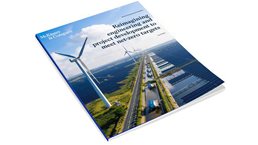Achieving net-zero carbon emissions is already seen as a “moon shot,” a highly ambitious undertaking through which an impossible goal is reached. The reality is even more challenging: if this goal is realized, it will be, in part, because permanent changes are made in the way capital projects are framed, financed, and delivered.
The difficulty is partly attributable to the many differences between net-zero projects and conventional ones. Most important is the much broader set of stakeholders involved—in effect, everyone on the planet. There is also increased urgency, given the potential damage inaction could cause to health and the economy. Yet, at the same time, the cost (or “green premium”) for consumers and taxpayers must be minimized. And then there is the goal: decarbonization, a dramatic reduction of the carbon footprint of construction—particularly the emissions associated with steel and concrete.
Overall, the global construction industry must deliver $9.2 trillion of clean-energy projects every year from 2022 to 2050, an increase of $3.5 trillion from current levels.1 This means the net-zero portfolio presents a dramatic shift in the allocation of capital to project types. For example, under a 1.5° pathway, the number of solar panels installed globally per week would be approximately eight times more than what occurs today, while the rate of wind-turbine installations would increase fivefold.
Simply conforming to past practices will not get the job done. A recent study of 3,022 infrastructure projects revealed that only 2.8 percent were completed on time and on budget.2 Performance on power projects was no better; McKinsey data indicate that the average capital-expenditure overrun was 50 percent higher than the original estimates, with final schedules 62 percent longer than originally planned.3 And although construction is the largest global industry sector, its productivity improvement has been less than a third of total economy averages.4
Meeting these challenges requires moving from established best practices that focus on optimizing individual projects to a top-down, portfolio-synergistic strategy that focuses on standardization, resource capacity, economies of scale, and predictable outcomes.
Would you like to learn more about our Global Infrastructure Initiative?
From project-centric to portfolio-synergistic
Project leaders have long relied on an accepted set of practices for project development and delivery. With costs ranging from hundreds of millions to tens of billions of dollars and durations often spanning a decade or more, large energy and infrastructure projects must be planned and executed with great care. Current best practices for project-centric strategies focus on processes and tools to manage the extensive time and effort invested in evaluating alternative strategies, fully defining the scope and developing detailed plans and estimates.
Projects in the net-zero portfolio are significantly different. Most green-energy projects comprise many identical or similar components whose installation involves relatively straightforward tasks repeated tens of thousands of times. For example, a solar photovoltaic (PV) facility can consist of more than 100,000 panels installed in identical fashion. Similarly, onshore wind farms can include more than 100 turbines. In both cases, many miles of transmission lines must be installed.
Another difference between green and conventional energy projects is the reversed priorities of capital cost (capex) versus operating cost (opex). In effect, capex is the new opex (Exhibit 1). Green energy’s zero cost of fuel and operational simplicity can shift the economic priority toward minimizing and controlling capital cost, which is further heightened by the imperative of minimizing additional costs to the consumer.

When considering the differences between a $10 billion investment in a net-zero portfolio of wind farms and solar parks and the same level of investment in a single large project, such as a new liquefied natural gas (LNG) plant, there are two primary advantages that the former has over the latter:
- Synergies: the combination of numerous similar projects to enable each to be designed and installed more efficiently
- Economies of scale: reductions in unit cost that occur through repetition. In commercial terms, this effect is commonly seen as discounts for large orders.
A portfolio-synergistic strategy enables both advantages to be captured (see sidebar, “Elements of a portfolio-synergistic strategy”). This strategy can be further leveraged by the experience accrued when groups of similar projects are delivered repeatedly over long periods of time.
In addition to wind and solar, the net-zero portfolio will include large green-energy projects, such as nuclear power plants. Because owners or operators typically focus on building one large project at a time, past practice has been to design each on a bespoke basis. Even in such cases, a portfolio-synergistic strategy can provide many benefits. For example, there is growing interest in small modular reactors, which can be factory-built and installed relatively quickly, greatly reducing financing costs.5 Other benefits of the portfolio-synergistic strategy include more effective quality control (in the shop versus in the field) and reduced design changes as the fleet expands.

Voices on Infrastructure: Reimagining engineering and project development to meet net-zero targets
Capturing the net-zero opportunity
In its report at the UN Climate Change Conference in Glasgow (COP26), the Glasgow Financial Alliance for Net Zero (GFANZ), a global coalition of leading financial institutions, provided an example of an investment road map for a group of 17 high-priority net-zero portfolios.6 Among these high-priority portfolios is Solar PV in Africa, which has some of the globe’s greatest potential for solar power generation. Although currently deployed in only a few African countries, solar PV is now the continent’s fastest-growing renewable energy source.7
The cost of the Solar PV in Africa portfolio is estimated at $488 billion over the next 20 years, an average of $24 billion per year. And while this is only a small fraction of the total net-zero investment, it is a massive undertaking that will likely involve all 54 African countries, the combined population of which totals 1.3 billion people. This would be a challenge under the best of circumstances, and the urgency of achieving net-zero emissions creates added pressure. A top-down, portfolio-synergistic strategy can improve past performance and enable these projects to be delivered efficiently (Exhibit 2).

Standardization
The portfolio-synergistic strategy begins with standardization. When done correctly, standardization can be highly effective. In fact, a recent research report from the Construction Industry Institute identified potential savings of 10 percent in capital cost, 15 percent of schedule duration, and 25 percent in life cycle cost.8
A large part of the Solar PV in Africa portfolio is likely to be commercial-scale installations that can use standard designs. While location factors will inevitably cause some design variations, standardization can be applied to solar PV in the following ways:
- Standard configurations and designs can be developed for key elements, such as panels, mounting structures and tracking systems, converters and transformers, and switchgear and cables.
- Design and quality standards for structural, mechanical, and electrical elements can be put in place and applied consistently across regions.
- Standard work processes, contract forms, and performance metrics can be used on solar PV projects throughout the region, enhancing efficiency and ensuring effective governance.
- Standard applications of technologies such as digital, drone, and new manufacturing applications can be implemented.
- Standardized manufacturing processes to enable new technologies to decarbonize the production of high-emission construction materials such as concrete and steel can be introduced and quickly matured.
Resource capacity
Standardization provides the basis for developing and sustaining the resource capacity required to provide the products and services to deliver the Solar PV in Africa portfolio. To begin, the combination of standardization with high confidence in the future workload enables the development of skilled resources, with associated opportunities becoming available for underemployed people in the region. Investments can be made in local manufacturing capacity for engineered products, raw and bulk materials, and prefabricated modules. Finally, opportunities are likely to arise for the formation of new businesses to supply goods and services within the region.
Economies of scale
The combination of standardized designs, requirements, and practices, with the associated expansion in regional resource capacity, provides the basis for economies of scale resulting from the following:
- cost savings associated with purchasing goods and services on a large scale over a sustained period
- reduced delivery times associated with efficiency gains as the volume of repetitive tasks and operations increases
- resilience built into the supply of critical materials and services, enabled by investor confidence in building local capacity
- a stable foundation for tracking efficiency, quality, and safety outcomes to identify gaps and continuously improve performance across the region
Predictable outcomes
Finally, standardization and scale enable comprehensive safety training, processes, and equipment in regional resource development programs, which can create confidence in achieving the highest levels of construction and operational safety. Such efficiencies can also help assure achievable estimates of cost, time, economics, regional benefits, and progress to net-zero emissions. Finally, the incorporation of decarbonization initiatives into standardized designs and practices, as well as into regional design and quality standards, can ensure measurable progress in reducing the carbon footprint.
With governments and the financial sector visibly focused on transformations to enable net-zero emissions, attention now swings to the construction sector, in which the urgency of climate change is matched only by the urgency of its own transformation. This requires answering two questions: first, how will the industry change current practices that have inhibited good performance; and second, how can the scale, long duration, and characteristics of the portfolio be leveraged? Failure is not an option. Transitioning from a conventional project-centric approach to one that is portfolio-synergistic will enable the synergies and economies of scale necessary for success.
This article is part of Global Infrastructure Initiative’s Voices on Infrastructure.
This article is the second in a series of five covering the challenges of delivering the net-zero portfolio and exploring the transformational opportunities it presents. The first, “Transforming capital projects to deliver net-zero emissions,” appeared in February. The next one, in June, will discuss ways to mobilize a step change in global resource availability.

